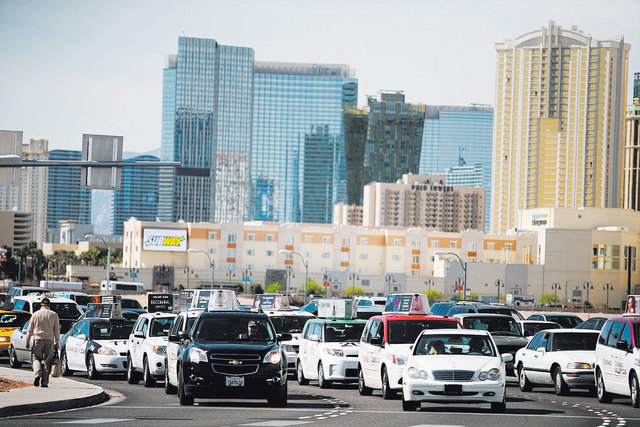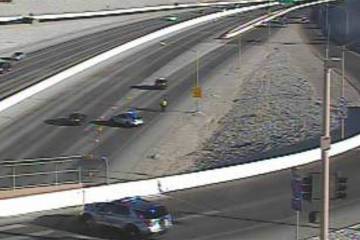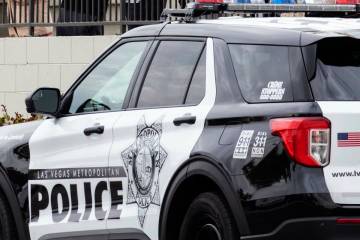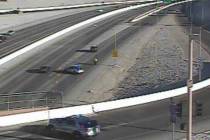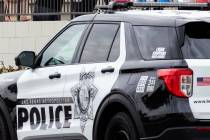Las Vegas cabdrivers warn 12-hour shifts exact a toll
Bus drivers transporting passengers over the nation’s highways can only go 10 hours after an eight-hour rest period before being required to stop or turn the wheel over to another driver.
But cabdrivers in Southern Nevada can drive — and often are required to drive — 12-hour shifts over several days at a time.
Veteran drivers say the pressures of a prospective competitive battle with Uber is resulting in cab owners demanding more from their drivers and to fill in more frequently for those who miss their shifts, making city streets more dangerous with a flood of exhausted cabbies.
It’s no secret that cab companies fear they’ll lose some of their best drivers when Uber relaunches service in Nevada.
Even though Uber’s contracted drivers won’t receive vacations, health insurance or retirement plans, they will get something cabdrivers value a lot — flexible hours and being their own boss.
“The first thing that’s going to happen if Uber comes back is that we are going to lose drivers — a lot of them — because many of them don’t look at the long term,” said Jamie Pino, director of operations for Nellis Cab Co. “They just look at being able to drive whenever they want. But within about six months, they’ll see that it isn’t what they thought it would be and they’ll come back. That’s what happened with Uber in San Francisco.”
Cab companies hope to counter Uber’s draw by helping their drivers make more money — by persuading them to take more shifts. Some drivers say they fear it’s only a matter of time before someone gets hurt or killed.
Four drivers working for three different companies spoke to the Review-Journal on the condition that they not be identified for fear that their bosses would fire them.
“It’s not a matter of if this is going to happen, it’s when it’s going to happen,” said one driver.
“I’ve seen guys come in on their shifts and say, ‘Please send me home, I’m exhausted,’ ” another added. “By day six, they’re walking zombies.”
Another driver said it’s common to see a cabby in line at a lightly trafficked resort catching a nap, counting on the driver behind him to wake him up with a tap on the horn, or retreating to a parking garage for a snooze.
Drivers are reluctant to turn down a shift because they fear their bosses will relegate them to areas of town with low potential for customers and tips.
Companies regularly review how much revenue each driver generates and give the best vehicles and the best areas to the drivers who bring in the most money. Some companies give shifts with reduced hours to the best producers.
The drivers who book the least revenue are subject to disciplinary action and even termination if they consistently bring in revenue below the daily average.
AND THEN THERE’S LONG-HAULING
The push to make more per shift drives another issue all too familiar to critics of the local taxi industry — illegal long-hauling of passengers.
Cabdrivers single out Nellis, Desert Cab and Lucky Cab, three of the smallest companies operating in Clark County, as most likely to pressure drivers to work more while also being most often accused of long-hauling.
Drivers say their bosses don’t endorse long-hauling but will look the other way or ignore mileage reported on trip sheets when drivers come in with abnormally high receipts. Although they’re among the smallest operators, Nellis and Desert consistently show the highest revenue per shift and the most revenue per trip among the 16 cab companies operating in the county, according to statistics from the Nevada Taxicab Authority.
In April, for example, the Taxicab Authority said the industry average revenue per shift was $286.57, while Nellis, Desert and Lucky averaged $339.65, $359.14 and $335.85, respectively.
Those companies also logged more revenue per trip than the $15.20 industry average. Respectively, Nellis, Desert and Lucky averaged $16.36, $17.43 and $15.85 in April.
Those companies accomplished that by running one or two trips per shift more than the industry average, according to the statistics.
Pino said his drivers beat the industry average because they hustle more than their competition. He added that his drivers technically don’t face 12-hour shifts because they’re required to take a lunch break sometime during their day.
Some drivers say otherwise. They say they often skip the break and their shifts exceed 12 hours because they are required to show up at least a half hour early to do paperwork before getting on the road.
Drivers also are concerned that cab companies will hire less experienced drivers to replace any who bail for greener pastures promised by transportation network companies.
As it is, cab companies have extremely high turnover rates and are in a perpetual state of hiring. Yellow Checker Star has an 80 percent annual turnover rate — and that’s one of the best in town. Others range as high as 120 percent per year, a cab company executive said.
Company managers say while most cab companies hire drivers that are 24 or older because of the higher cost of insuring younger motorists, some companies, including Yellow Checker Star, can hire drivers as young as 21 because they self-insure.
But Yellow Checker Star also has a strong safety program that includes regular training in a driving simulator and in-vehicle cameras that monitor driver behavior. Evidence of an accident or driver mistake is captured on tape and included in a video loop played on break room televisions.
Drivers can be disciplined, even fired, if caught making too many mistakes behind the wheel.
A STABLE ACCIDENT RATE
For all the drivers’ concerns about safety being sacrificed as a result of fatigue behind the wheel, the accident rate has been stable over the past two years — and data provided by the Taxicab Authority show a downward trend over the past three years.
In 2013, there were 23 accidents per 100,000 cab rides, with the industry operating 26.4 million rides.
In 2014, there were 22.8 accidents per 100,000 rides based on 27.6 million rides.
In the first four months of this year there have been 22.2 accidents per 100,000 rides based on 9.3 million trips.
Ruben Aquino, chief of the Taxicab Authority enforcement division, also cautioned that an “accident” has a broad meaning.
Local police who investigate crashes notify the authority every time a taxi is involved in a driving mishap, no matter how small or seemingly insignificant. That’s because inspectors are required by law to check out a vehicle before allowing it back in service.
So some “accidents” may involve nothing more than hitting a curb or tapping the bumper of another vehicle.
By contrast, regulators lack resources to check how frequently a driver works. They rely on the companies to monitor how often they’re on the road.
That’s another part of the problem, the drivers said.
“When you’ve been out there for, say, 10 hours straight and you’re not as sharp as you should be, isn’t that dangerous, especially in a city that relies so much on taxis and tourists?” one driver asked. “All it’s going to take is one bad accident to hurt us all. It’s just not worth it.”
Contact reporter Richard N. Velotta at rvelotta@reviewjournal.com or 702-477-3893. Find him on Twitter: @RickVelotta



